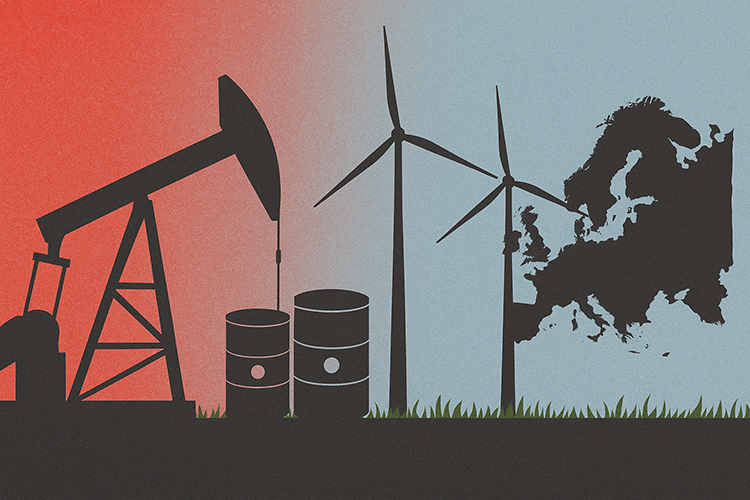Russia’s Energy Grip on Europe Falls Sharply Since 2021, But Influence Persists in the South
Europe’s reliance on Russian oil and gas has undergone a dramatic reversal since 2021, with Moscow’s once-dominant position in the continent’s energy markets reduced to a fraction of its former share. A combination of sanctions, nationalisations, and supply diversification has left Russian firms with far less influence over European households and industry than before the war in Ukraine.
In 2021, Russian suppliers provided close to half of the European Union’s imported natural gas—around 155 billion cubic metres per year. That flow was underpinned by pipelines such as Nord Stream 1, Yamal–Europe and transit routes through Ukraine, with additional volumes moving via the Black Sea into Türkiye and the Balkans. Many countries in Central and Eastern Europe were almost entirely dependent on Russian molecules for heating and power, while Russian companies also controlled major underground storage facilities in Germany, Austria and the Netherlands. By contrast, in 2024 Russia accounted for only about 11 percent of Europe’s pipeline gas and less than 19 percent once liquefied natural gas is included.
Oil followed a similar path. Before the war, Russia was the largest single source of crude for the EU, covering nearly a third of imports, and supplied close to 40 percent of refined oil products such as diesel. Companies like Rosneft and Lukoil held strategic positions inside the bloc, including majority stakes in three German refineries and full ownership of major facilities in Romania and Bulgaria. Today, seaborne crude from Russia has been largely eliminated under EU bans, reducing its share to roughly 2 percent, while Berlin has placed Rosneft’s German refinery stakes under state trusteeship. Lukoil has sold or is in the process of selling assets, including its 84-megawatt Romanian wind farm, which passed to Greece’s PPC in 2024, and its Burgas refinery in Bulgaria, now on the market.
The restructuring has been especially visible in Germany, where Gazprom’s former subsidiary Gazprom Germania was nationalised and reborn as Securing Energy for Europe (SEFE), a state-owned company that now controls key storage, trading, and pipeline interests. Poland has taken similar steps, removing Gazprom from the Yamal–Europe pipeline on its territory and seizing Novatek’s local assets.
Renewable energy, once a minor sideline for Russian groups, has also slipped away. Lukoil’s wind and solar investments in Romania and Bulgaria were small compared with its fossil portfolio and have largely been divested. Gazprom Neft’s Serbian unit NIS continues to build modest solar capacity, but larger wind projects remain stalled.
Yet while Moscow’s overall position has been cut back sharply, it has not disappeared altogether. Gas still flows to Türkiye and onward to southeast Europe through pipelines under the Black Sea, feeding countries such as Hungary, Slovakia, and Serbia. Russian companies also remain active in Serbia’s oil and gas group NIS and in Bosnia’s refinery network, while Moldova continues to wrestle with the legacy of Gazprom’s role in its gas distributor.
Another enduring channel is liquefied natural gas. Shipments from Russian producers continue to arrive at European ports, particularly in France, Belgium, Spain, and the Netherlands, making up a notable share of imports. Brussels has set a 2027 deadline to end these purchases, but the trade remains one of the most sensitive political questions in energy policy.
Europe’s households have felt the impact of these shifts most directly. Gas once accounted for nearly a third of domestic energy use, leaving families exposed to swings in Russian deliveries. But with new LNG terminals, pipeline links to Norway and Azerbaijan, and an EU-wide policy of filling storage to over 90 percent before winter, that vulnerability has eased. Italy and Hungary remain relatively gas-heavy in their household mix, while non-EU countries such as Serbia, Moldova and Türkiye still source significant volumes from Russia.
The transformation is stark: in 2021 Moscow was both the EU’s largest gas supplier and its top crude provider, with controlling stakes in critical refineries, storage hubs and cross-border pipelines. By 2025, its share of Europe’s energy mix is a fraction of what it was, its refinery stakes are neutralised under trusteeship, and its renewables footprint has almost vanished. What remains are contractual ties in a handful of countries, physical flows through Black Sea pipelines, and continued sales of liquefied gas, which the EU has pledged to phase out by 2027.
Source: comp.








